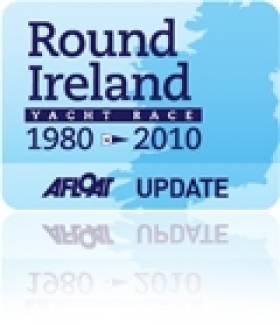Displaying items by tag: Sadie Phelan
Sadie Phelan 1950-2021
The sudden death of Sadie Phelan after a short illness has been a matter of great regret and sadness in Wicklow and beyond in Ireland, and in a wider world which shared her enthusiastically pursued interests.
She was an active and hard-working member of Wicklow Sailing Club for over forty years, holding several roles in the club. In 2010, the 60th anniversary of the club's foundation, she was elected to become the first ever Lady President. She served for the maximum two terms, from 2011 to 2016 inclusive, presiding over six years of notable achievement during which WSC put its flagship event, the biennial Round Ireland Yacht Race, on a sound footing with reinforced links to the Royal Ocean Racing Club and a new partnership with the Royal Irish Yacht Club, while the Club's developing training programme saw an increasing number of young Wicklow sailors such as Brian Flahive and Barry Byrne making their mark nationally and internationally.
In earlier years, she had been a hard-working Honorary Club Secretary for some time. This was in the days when the minutes of a meeting were carefully transcribed by hand into the Minute Book, with Sadie setting a standard which was to stand the club in good stead in the years ahead.
 "When the world comes to Wicklow…" – classic Round Ireland Race start off the Wicklow pierhead
"When the world comes to Wicklow…" – classic Round Ireland Race start off the Wicklow pierhead
She was also the WSC representative on the Irish Sea Offshore Racing Association, and due to her strong contacts in that group, the club hosted many ISORA race finishes. These were hugely beneficial to the club in both economic and reputational terms, and Peter Ryan, ISORA Chairman, has spoken in recent days of her great commitment and enthusiasm for the Association.
In addition, Sadie coordinated for many years the celebratory Dinner and Prize Giving night for the Round Ireland Yacht Race and that – together with her frequent presence in the Race Office while the event was taking place - saw her becoming friends with many of the regular Round Ireland race competitors. She was a welcoming face to so many RI crew as they arrived exhausted in Wicklow after the race. At all hours of the day and night, Sadie and the catering volunteers provided the sailors with warm, welcome smiles, hot food and relaxing drink.
It's no exaggeration to say Sadie loved Wicklow Sailing Club, and it was a special pleasure to her that in her final year as President, WSC became the Mitsubishi Motors "Sailing Cub of the Year" for 2016. She enjoyed meeting people there, and was often a key figure in successful social and fund-raising events. In particular, she was renowned for her wonderful cheese and wine evenings. And in latter years, Sadie was a regular member of The Sunday Group, a small group of WSC members who enjoy reminiscing together on a Sunday afternoon in the clubhouse.
 Wicklow Sailing Club "At Home" – Sadie Phelan played a leading role in making the club a byword for warm hospitality on a year-round basis
Wicklow Sailing Club "At Home" – Sadie Phelan played a leading role in making the club a byword for warm hospitality on a year-round basis
Another passion was singing When she and Paul established an up-country base at Tinahely in one of the loveliest yet least-known parts of County Wicklow, she brought the enthusiasm and talent which we know so well in Wicklow town to the Tinahely Women's Choir, and as with everything to do with Sadie, her enjoyment and talent was infectious.
She will be much missed. Wicklow Sailing Club Commodore Kyran O'Grady has paid tribute to her for the many years of dedication to the club, and her enthusiasm for all aspects of club life. She was a great ambassador, not only for Wicklow SC, but also for the Round Ireland Yacht Race, for ISORA and for sailing generally.
Sadie's untimely passing is a great loss. We would like to extend our sympathy to Paul, to Lisa and Alan and their partners, to her sister Joan, to her grandchildren, to Theo and Orlagh, and to all her extended family.
(Sadie's family suggest that anyone who might have wished to show sympathy by bringing flowers to the funeral might like to donate to the RNLI via https://sadiephelan.muchloved.com)
PS
Wicklow Sailing Club President Sadie Phelan RIP
With great regret we record the death today (Wednesday) of Sadie Phelan, President of Wicklow Sailing Club since 2011, and a longtime and tireless voluntary worker on behalf of WSC and sailing generally, particularly with the biennial Round Ireland Race.
A full appreciation will appear in Afloat.ie in due course, for now our thoughts and heartfelt condolences are with her family, her numerous friends, and with those many participants who have the fondest memories of her supportive presence at the Round Ireland Race's starts and finishes.
Sadie Phelan is First Lady President of Wicklow Sailing Club
Round Ireland organiser, Wicklow Sailing Club has elected its first Lady President in the 60th anniversary year of the club.
Long time resident of Wicklow, Sadie Phelan, has been very involved in many roles in the club previously, having served as its Honorary Secretary for several years. Phelan also served as Wicklow SC ISORA representative as well as organising many fundraising and social events including the Round Ireland Prizegiving dinners.
This is a great honour for Sadie and her family and she will be a worthy ambassador for the members of WSC with her wide circle of sailing friends from both sides of the Irish Sea.





























































